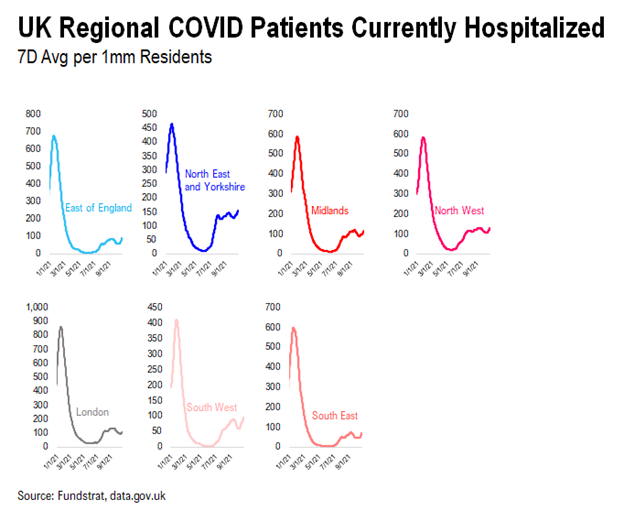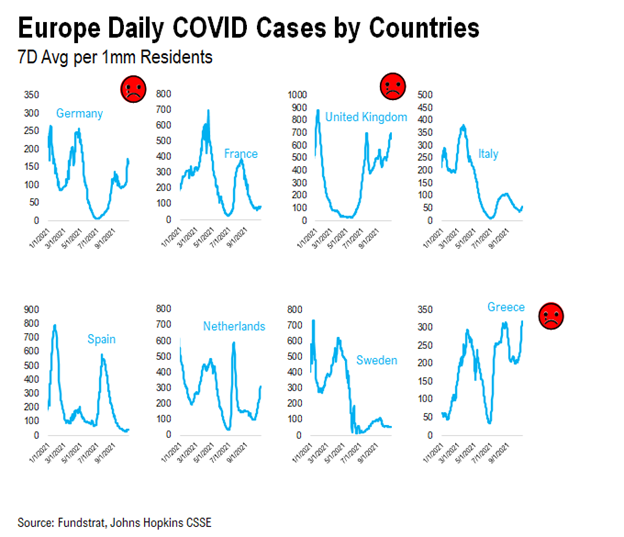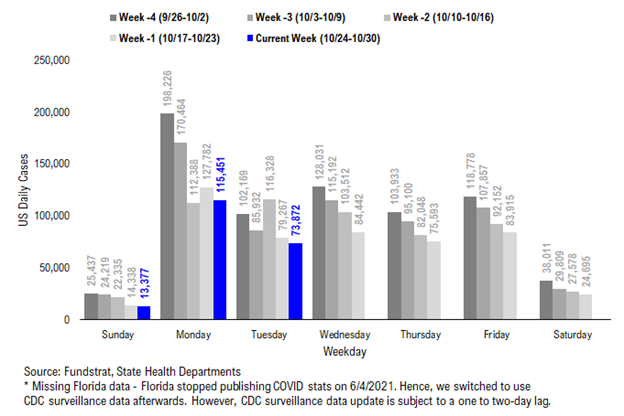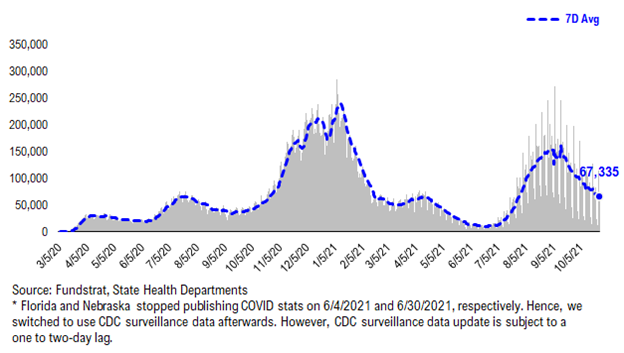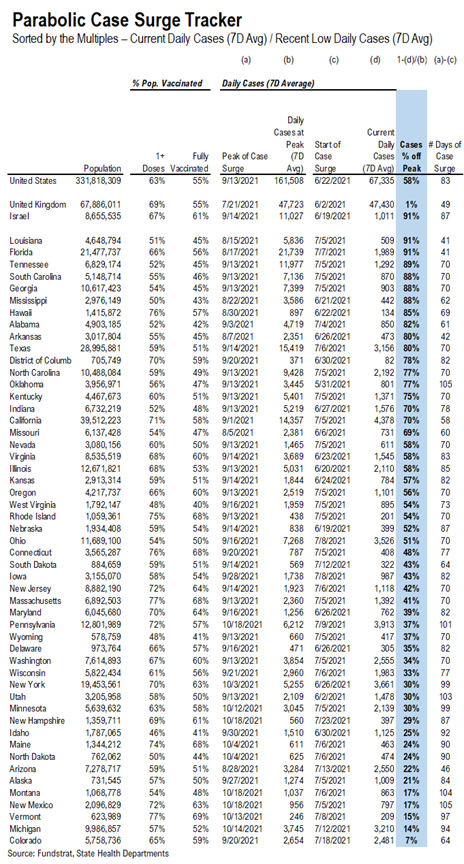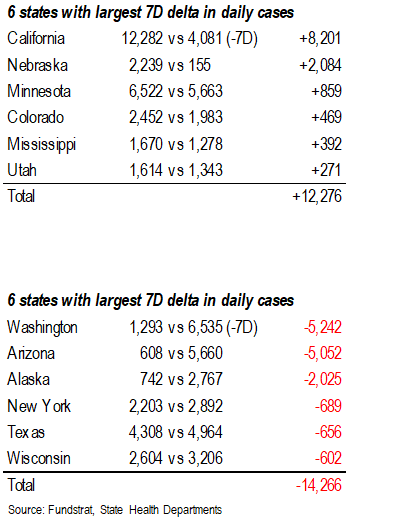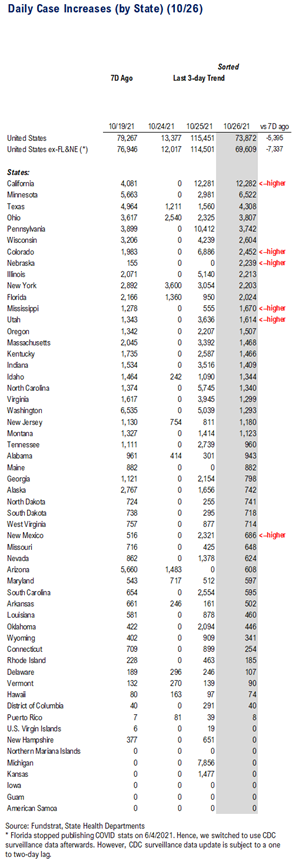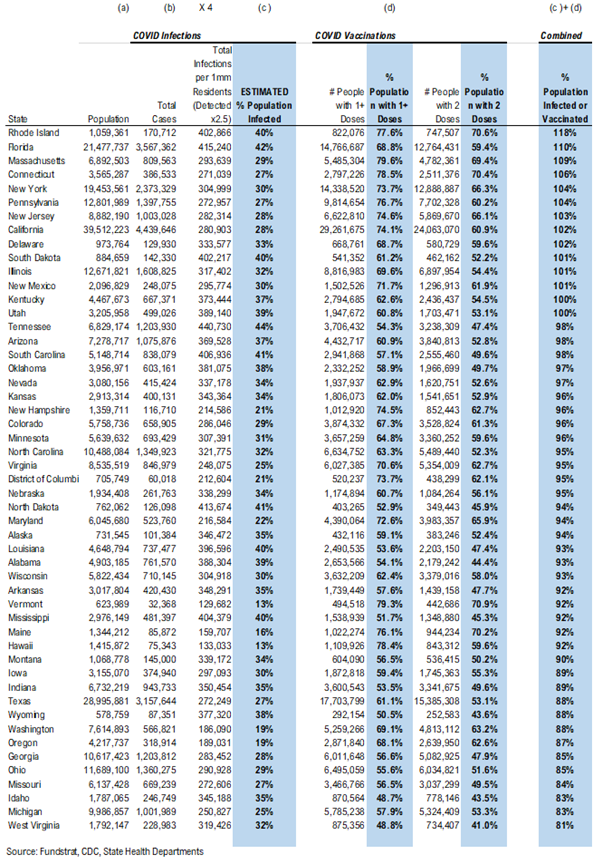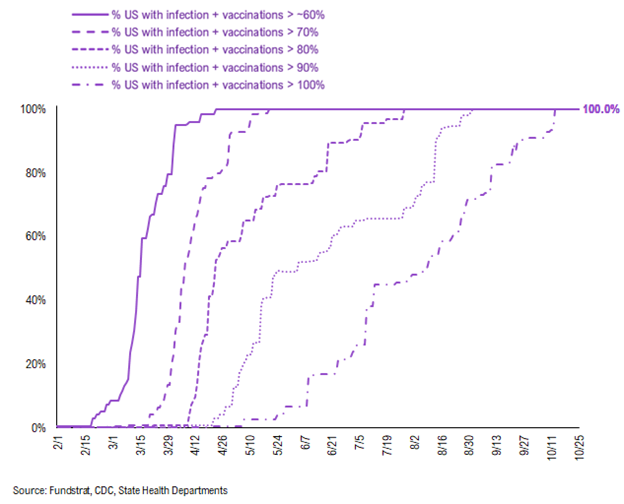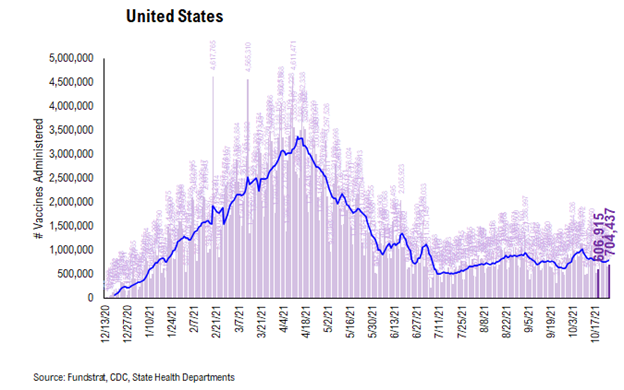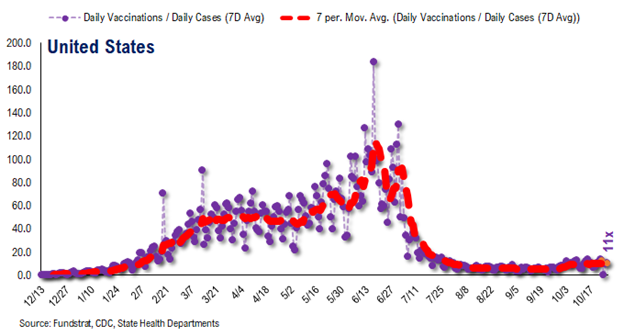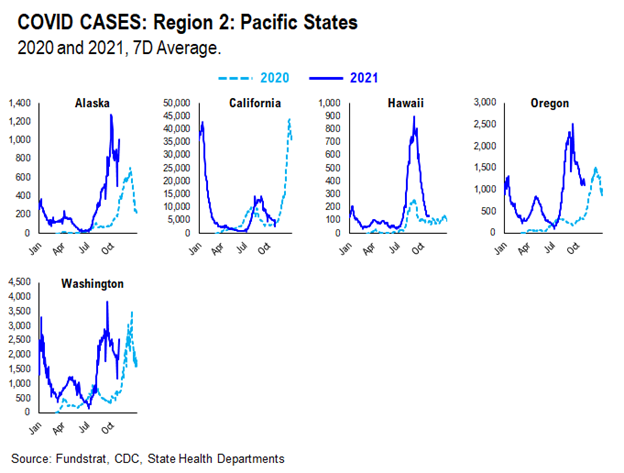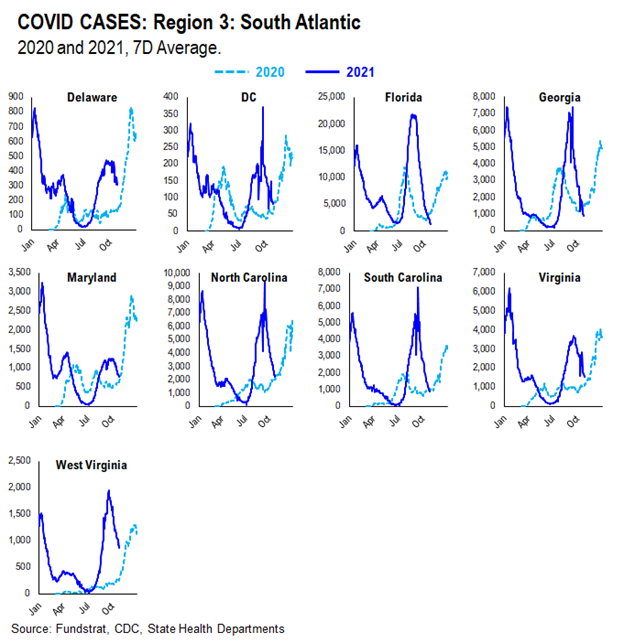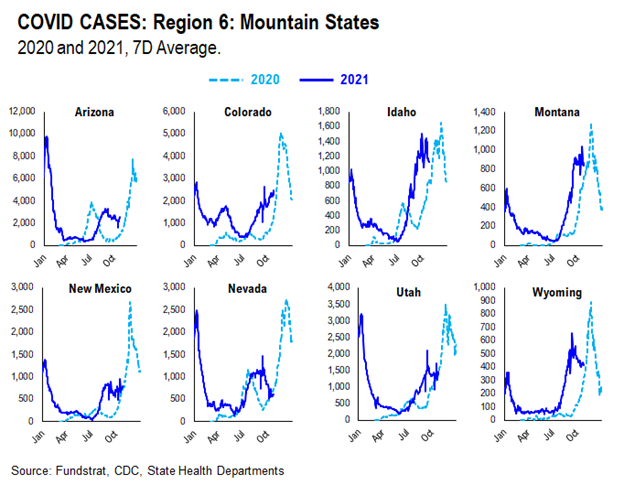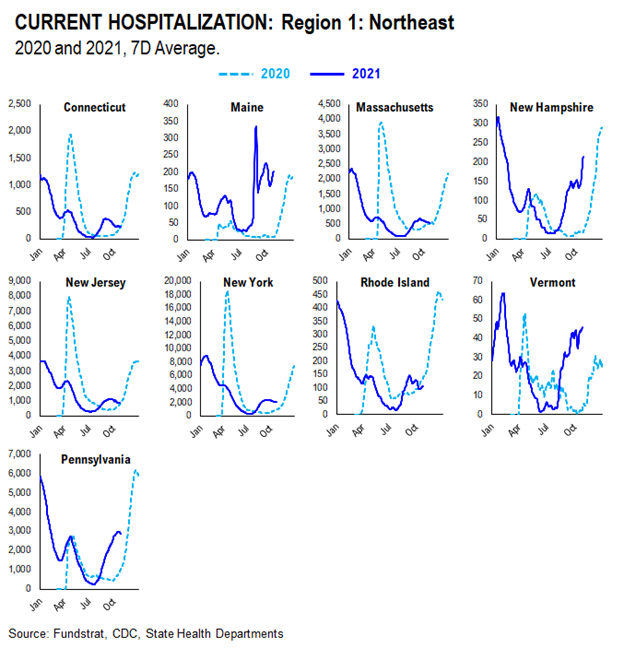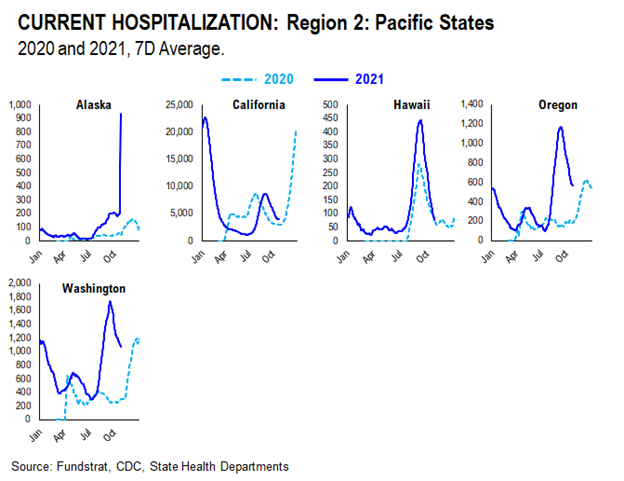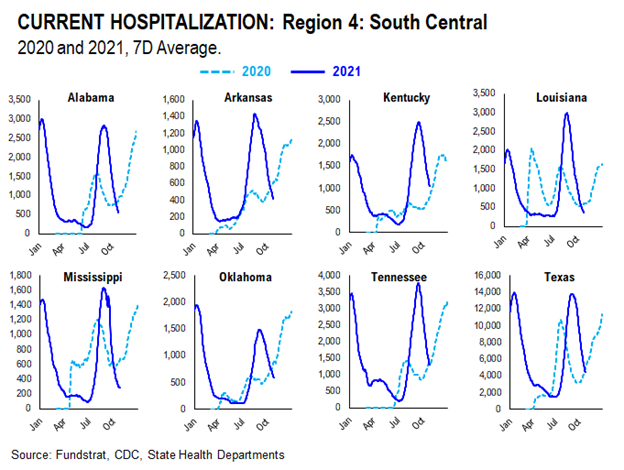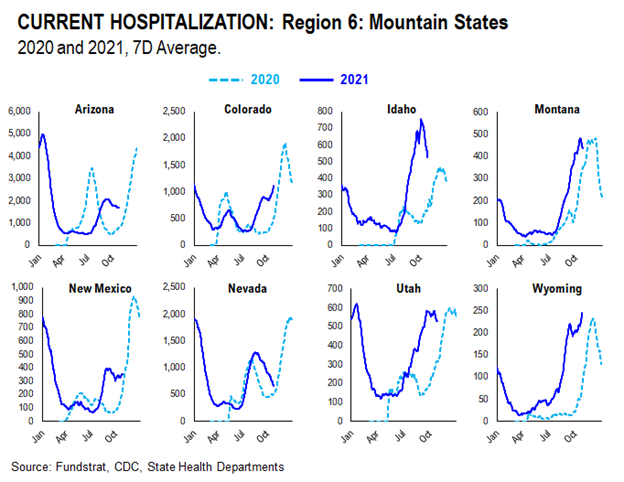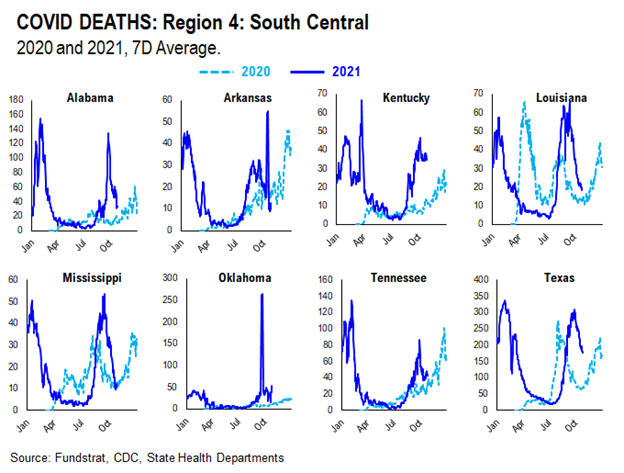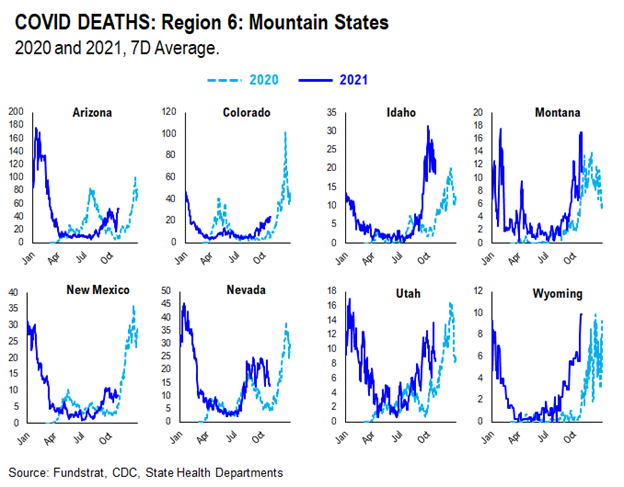Market leadership still "early cycle" --> Delta-plus not creating "delta" vs base case as European delta-plus not driving severe hospitalizations
Click HERE to access the FSInsight COVID-19 Daily Chartbook.
We publish on a 4-day a week schedule:
Monday
Tuesday
Wednesday
SKIP THURSDAY
Friday
STRATEGY: Delta-plus surge not creating “delta” in our base case
US daily case trends are still positive — 7D avg 67,355 or 58% off recent peak
US daily case trends continue to be promising. And as we noted earlier this week, it is 9 states seeing some type of rise but 41 are seeing steep declines. Including multiple states with >80% declines in cases.
This table is in section #1 and is sorted by states % off the recent highs. Leading this:
– Louisiana and Florida, both 91% off their highs
– even Texas is 80% off their recent highs
– most states >80% off their highs are in the South
So naturally, given the cooling weather north, we are watching emerging case trends in the Northeast. And as we noted, it is a mixed bag with only VT, NH, ME and maybe PA being of concern.
Confusing but Delta –> Delta-plus is actually B.1.617.2 –>AY.4.2
I have become confused about the lineage of the Delta-plus, since it is referred to as AY.4.2, but the original Delta (aka Kappa) was designated B.1.617. Fortunately, tireless Ken compiled the lineage of the Delta-plus:
– B.1.617 has 3 main sub-lineages: within them,
B.1.617.1 is named as kappa variant,
B.1.617.2 is named as delta variant
– AY is a further evolutionary step forward from b.1.617.2 (delta variant)
– there are 75 AY lineage identified.
– AY.4 is the widest spread one
– AY.4.2 (delta-plus) is a sub-lineage of AY.4
So basically, B.1.617 -> B.1.617.2 (delta) -> AY -> AY.4 -> AY.4.2(delta plus). The reason the variant name doesn’t keep going B.1.617.2.x.x.x.x.x is:
– Once a lineage’s labelling gets five levels deep,
– A new letter combination is started to avoid the name getting too long
So, Delta plus is not really an official name from WHO… but people use it as “a plus version” of the delta variant.
…IHME does not see UK Delta-plus spilling into the US
Below is the updated forecasts from the IHME (Institute for Health Metrics, the forecasting firm used by many policymakers) for UK and USA. Given the surge in Delta-plus cases in the UK, I wanted to see how the IHME is forecasting the trend in US cases:
– IHME sees UK cases surging until Jan 2022
– this infection wave should surpass all prior highs for the UK
– IHME sees US cases rising through Jan 2022 as well
– but this is a modest rise
– well below the Summer 2020 highs
So interestingly, the IHME sees the US having a relatively mild COVID-19 winter for the US. This is quite encouraging and further supports that the US risk-on could continue. Moreover, this would argue the US should outperform (to the extent COVID-19 case trends differentiate markets, which it has in 2021).

UK case trends still rising but London seems to be avoiding the worst of it so far
In terms of daily cases detected, the 9 regions of the UK are all seeing an increase. But London remains an outlier, as cases per 1mm residents are still well below Jan 2021 highs. In fact, at ~350 cases per 1mm residents, London is far lower than the rest of UK.
– a few weeks ago, the rest of the UK, outside of London, saw a surge in cases
– London began to see a rise in cases
…UK hospitalizations muted throughout UK
Hospitalizations have been muted throughout the UK as shown on the 7 regions below. Even with regions seeing all-time highs in detected cases, hospitalizations have been relatively muted.
– Midlands is a good illustration
– Daily cases are at all-time highs
– Hospitalizations are up but muted
So, while detected cases are surging, the corresponding number requiring hospitalizations is still low.
…Continental Europe only seeing cases rise in Germany and Greece
Of the 7 largest nations in Europe, only Germany and Greece are seeing a rise in detected cases. This is pretty surprising:
– Germany cases are up modestly
– Greece has surged to new all-time highs
– But cases are still falling in
– Spain
– France
– Italy
– and Sweden
And trends in hospitalizations have been promising throughout Greece, Germany, UK and the rest of Europe. This reflects the benefit of vaccinations, presumably, and also mitigates concerns about the potential severity of the Delta-plus driving a surge in hospitalizations. Again, promising trends and bears watching. These trends could change.
STRATEGY: Leadership from prior high to new high is early cycle –> still see YE rally
Many pundits are suggesting the US economy is entering mid-cycle. And as such, investors need to alter sector positioning for a mid-cycle move. Mid-cycle generally means the economy is maturing, thus:
– growth slows –> favor Growth stocks
– margins mature –> favor secular growers
– balance sheet risk rises –> favor high quality
– interest rates rise –> favor low debt
– inflationary pressures emerge –> favor inflation sensitives (oil).
But does sector returns, since making new highs, look consistent with this view? Below is the comparative sector returns from 9/2/2021 (prior high) to yesterday (new “high”) and sorted best to worst:
– Energy is best performing +23%
– Discretionary and Financials +6%
– 3 sectors matched S&P 500
But as we notate on the table below, the leadership in sectors has come from early cycle groups. In other words, as COVID-19 cases waned in the past 6-8 weeks, and equities pushed to new highs, the leadership has come from cyclically sensitive groups. More specifically, groups considered early cycle.
EARLY CYCLE: Leadership of Energy, Transports, Financials and Discretionary
You might be familiar with our sector leadership chart below, which generally stages sector leadership based on the business cycle:
– Recent leadership is being driven by early cycle sectors
– Early cycle: Transports, Financials
– “early” Early cycle: Discretionary Banks
– Energy leading, which is historically “late cycle” because inflation pressures develop late
– but in 2021, the supply/demand tightness is creating a rise in oil prices
If one tends to believe markets are a better guage of underlying trends, the sector leadership recently seems to point to an economy early cycle. In other words, despite the multiple headwinds of:
– supply chain glitches
– rising labor costs
– rising interest rates
It seems the equity markets are suggesting that the US recovery is still closer to early cycle. And as we noted yesterday, the fact that there appears to be additional slack in both manufacturing (capacity utilization is 75%) and labor markets (employed to population ratio), these would tend to push us into the “transitory” category for inflation pressures. The US is only 1-year into an expansion, so from a timeline perspective, the US also looks more early cycle.
FINANCIALS: Leadership is banks, asset managers + consumer finance = signs of early cycle
Even looking within Financials, we can see that leadership by industry is quite pronounced:
– Leading are Banks, Asset Managers, Investment Banks and Consumer Finance
– Lagging are Insurance groups
– Turning is “Multi-line” and Insurance brokers
Again, this is essentially what we expect to see if the US economy was early cycle. Thus, if it walks like “early cycle” and talks “early cycle,” it is probably _____________.
…Energy + Bitcoin does show market is worrying about inflation surging
Does this make sense? Below is simplified checklist. And we look at 3 scenarios:
– Inflation surge
– Cyclical recovery (reflation)
– “peak growth” = bad
The two best performing sectors under inflation surge should be Energy (oil) and Bitcoin (hedge). This seems to be what the market is discounting at the moment. That is not our central case, however. But again, this seems to be what the market is discounting.
– into YE, our favorites
– Energy
– Epicenter XLI 0.11% XLF 0.60% XLB 0.85% RCD
– Crypto BITO 2.64% GBTC 2.72% BITW 3.20%
30 Granny Shot Ideas: We performed our quarterly rebalance on 10/25. Full stock list here –> Click here
POINT 1: Daily COVID-19 cases 73,872, down -5,395 vs 7D ago…
Current Trends — COVID-19 cases:
- Daily cases 73,872 vs 79,267 7D ago, down -5,395
- Daily cases ex-FL&NE 69,609 vs 76,946 7D ago, down -7,337
- 7D positivity rate 4.8% vs 5.1% 7D ago
- Hospitalized patients 47,829, down -9.7% vs 7D ago
- Daily deaths 1,352, up +10.7% vs 7D ago
*** Florida and Nebraska stopped publishing daily COVID stats updates on 6/4 and 6/30, respectively. We switched to use CDC surveillance data as the substitute. However, since CDC surveillance data is subject to a one-to-two day lag, we added a “US ex-FL&NE” in our daily cases and 7D delta sections in order to demonstrate a more comparable COVID development.
The latest COVID daily cases came in at 73,872, down -5,395 vs 7D ago. As evident by the consistently negative 7D deltas, and as seen below, cases are currently rolling over.
Rolling 7D delta in daily cases remains negative…
The rolling 7D delta remains negative as cases are rolling over.
Low vaccinated states seem to have a larger increase in daily cases compared to their recent low…
*** We’ve updated the “Parabolic Case Surge Tracker” to measure case % off recent peak as the more recent “delta surge” is rolling over.
In the table, we’ve included both the vaccine penetration, case peak information, and the current case trend for 50 US states + DC. The table is sorted by case % off of their recent peak.
– The states with higher ranks are the states that have seen a more significant decline in daily cases
– We also calculated the number of days during the recent case surge
– The US as a whole, UK, and Israel are also shown at the top as a reference
Hospitalizations, deaths, and positivity rates are rolling over amidst case rollover…
Below we show the aggregate number of patients hospitalized due to COVID, daily mortality associated with COVID, and the daily positivity rate for COVID.
– Net hospitalizations peaked below the Wave 3 peak and are currently rolling over
– Daily death peaked slightly above the Wave 2 peak and are currently rolling over
– As per the decline in daily cases, the positivity rate is currently rolling over
POINT 2: VACCINE: vaccination pace trending up once again…
Current Trends — Vaccinations:
- avg 0.8 million this past week vs 0.8 million last week
- overall, 57.1% fully vaccinated, 65.9% 1-dose+ received
Vaccination frontier update –> all states now near or above 80% combined penetration (vaccines + infections)
*** We’ve updated the total detected infections multiplier from 4.0x to 2.5x. The CDC changed the estimate multiplier because testing has become much better and more prevalent.
Below we sorted the states by the combined penetration (vaccinations + infections). The assumption is that a state with higher combined penetration is likely to be closer to herd immunity, and therefore, less likely to see a parabolic surge in daily cases and deaths. Please note that this “combined penetration” metric can be over 100%, as infected people could also be vaccinated (actually recommended by CDC).
– Currently, all states are near or above 80% combined penetration
– Given the new multiplier. only RI, FL, MA, CT, NM, NY, NJ, IL, CA, PA, DE, SD, KY, and UT are now above 100% combined penetration (vaccines + infections). Again, this metric can be over 100%, as infected people could also be vaccinated. But 100% combined penetration does not mean that the entire population within each state is either infected or vaccinated
Below is a diffusion chart that shows the % of US states (based on state population) that have reached the combined penetration >60%/70%/80%/90%/100%. As you can see, all states have reached combined infection & vaccination >100% (Reminder: this metric can be over 100%, as infected people could also be vaccinated. But 100% combined penetration does not mean that the entire population within the state is either infected or vaccinated).
There were a total of 704,437 doses administered reported on Tuesday, up 16% vs. 7D ago. While we are seeing the vaccination pace slow down, we believe it may soon pick back up as booster shots are becoming more widely available. Also, the same catalysts remain in place:
– Proof of vaccination required by many US cities and venues
– Booster shots
– Full FDA approval of Pfizer COVID vaccines (hopefully it could help overcome vaccine hesitancy)
– Biden’s vaccination plan
The daily number of vaccines administered remains the most important metric to track this progress and we will be closely watching the relevant data.
73.9% of the US has seen 1-dose penetration >60%…
To better illustrate the actual footprint of the US vaccination effort, we have a time series showing the percent of the US with at least 45%/45%/50% of its residents fully vaccinated, displayed as the orange lines on the chart. Currently, 100% of US states have seen 40% of their residents fully vaccinated. However, when looking at the percentage of the US with at least 45% of its residents fully vaccinated, this figure is 97.3%. And only 81.9% of US (by state population) have seen 50% of its residents fully vaccinated.
We have done similarly for residents with at least 1-dose of the vaccination, denoted by the purple lines on the chart. While 98.9% of US states have seen 1 dose penetration >50%, 90.6% of them have seen 1 dose penetration >55% and 73.9% of them have seen 1 dose penetration > 60%.
This is the state by state data below, showing information for individuals with one dose and two doses.
The ratio of vaccinations/ daily confirmed cases has been falling significantly (red line is 7D moving avg). Both the surge in daily cases and decrease in daily vaccines administered contributed to this.
– the 7D moving average is about ~11 for the past few days
– this means 5 vaccines dosed for every 1 confirmed case
In total, 408 million vaccine doses have been administered across the country. Specifically, 219 million Americans (66% of US population) have received at least 1 dose of the vaccine. And 189 million Americans (58% of US population) are fully vaccinated.
POINT 3: Tracking the seasonality of COVID-19
In July, we noted that many states experienced similar case surges in 2021 to the ones they experienced in 2020. As such, along with the introduction of the more transmissible Delta variant, seasonality also appears to play an important role in the recent surge in daily cases, hospitalization, and deaths. Therefore, we think there might be a strong argument that COVID-19 is poised to become a seasonal virus.
The possible explanations for the seasonality we observed are:
– Outdoor Temperature: increasing indoor activities in the South vs increasing outdoor activities in the northeast during the Summer
– “Air Conditioning” Season: similar to “outdoor temperature”, more “AC” usage might facilitate the spread of the virus indoors
If this holds true, seasonal analysis suggests that the Delta spike could roll over by following a similar pattern to 2020.
We created this section within our COVID update which tracks and compare the case, hospitalization, and death trends in both 2020 and 2021 at the state level. We grouped states geographically as they tend to trend similarly.
CASES
It seems as if the main factor contributing to current case trends right now is outdoor temperature. During the Summer, outdoor activities are generally increased in the northern states as the weather becomes nicer. In southern states, on the other hand, it becomes too hot and indoor activities are increased. As such, northern state cases didn’t spike much during Summer 2020 while southern state cases did. Currently, northern state cases are showing a slight spike, especially when compared to Summer 2020. This could be attributed to the introduction of the more transmissible Delta variant and the lifting of restrictions combined with pent up demand for indoor activities.
HOSPITALIZATION
Current hospitalizations appear to be similar or less than Summer 2020 rates in most states. This is likely due to increased vaccination rates and the vaccine’s ability to reduce the severity of the virus.
DEATHS
Current death rates appear to be scattered compared to 2020 rates. This is likely due to varying vaccination rates in each state. States with higher vaccination rates seem to have lower death rates given the vaccine’s ability to reduce the severity of the virus; states with lower vaccination rates seem to have higher death rates.
More from the author
Articles Read 1/2
🎁 Unlock 1 extra article by joining our Community!
Stay up to date with the latest articles. You’ll even get special recommendations weekly.
Already have an account? Sign In 6cc238-130703-becefd-1866d4-64f247
Already have an account? Sign In 6cc238-130703-becefd-1866d4-64f247






